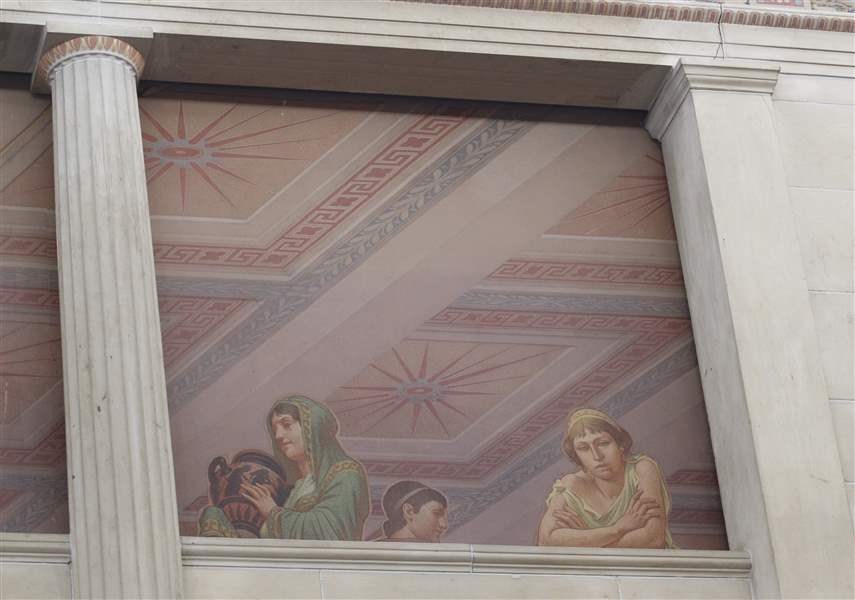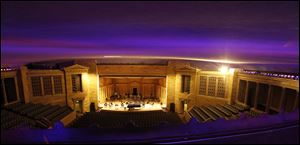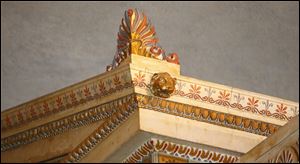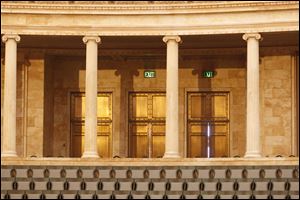
TOLEDO MAGAZINE
Toledo Museum of Art Peristyle: A show all by itself
4/4/2011
On the upper story of the Peristyle lobby, a painted frieze depicts Greek citizens watching the activity below.
THE BLADE/JETTA FRASER
Buy This Image

The view of the Peristyle from the light control room.
January, 1933: After two years, construction of the Toledo Museum of Art Peristyle is complete. Conductor Leopold Stokowski and the Philadelphia Orchestra have arrived to perform at a gala dedication concert that will draw people from around the country. But Stokowski thinks the perforated acoustical panels on the wall of the upper promenade aren’t providing enough sound absorption. He takes a pencil up there and stabs away at them.

On the upper story of the Peristyle lobby, a painted frieze depicts Greek citizens watching the activity below.
It’s a neat little story told by Julie McMaster, museum archivist, about a place that has been called one of the most beautiful concert halls in America. Architectural features, large and small, and recurring colors and shapes throughout the public spaces put an elegant 20th-century spin on a classical open-air theater in ancient Greece.
The building was designed by Edward B. Green of Buffalo and built by A. Bentley & Sons of Toledo.
The design — and indeed the Peristyle itself — was the dream of Florence Scott Libbey, Ms. McMaster says.
"It is very unusual to have a concert hall that is part of a museum, and to take up so much of the space — one-third of the museum," she adds. "She believed that music was an art and that it belonged in a museum."

Large palmette ornaments top the porticos. The ornaments were used in Greece on the four corners of a roof to cover wooden ridge beams.
Concert-goers can’t miss the Peristyle’s "sky" or its curving row of 28 Ionic columns that surround the seating area. Take a closer look to see some of its other details:
The main lobby is designed as an open-air Greek marketplace. On the wall above the ornate bronze doors that lead into the concert hall is a mural depicting second-story rooms from which people peer down on the activity in the square. The lobby ceiling, like the one in the Peristyle, is constructed and lit to give the impression of a sky.
In the lounge to the right of the lobby is the original light board that was backstage until it was replaced by a compact computerized system in 1987. Its knobs, levers, switches, and other gizmos take up an entire wall.
Custom-made benches, handpainted borders, and overhead beams in the lobby and lounges thoughtfully repeat decorative motifs.
Entering the Peristyle, stone floors of the lobby change to cork. It’s waxed on the upper and lower promenades, but left unwaxed in the seating areas because wax affects sound quality.

Seating capacity is 1,742, including 1,500 fixed seats on the main floor and seven raised sections. The rest are straight-back chairs behind the row of 28 Iconic columns.
Those curious drain-like openings under the seats? They’re part of the heating, ventilating, and air-conditioning system.
To the right and left of the stage are porticos that screen the organ chambers. At the top are palmette ornaments and elaborate stone carvings.
The five medallions across the top of the stage are: Pegasus, the mythological horse with wings; Mercury, the messenger god who the Greeks believed invented the lyre; Apollo, god of music, who is represented by a lyre and swans; Terpsichore, muse of dance, and Daedalus, Greek patron of artists and craftsmen.
Among the things you can’t see: clear, red, and blue lights just under the rim of the domed ceiling that change colors of the "sky" from daylight to the pink and purple of sunset to deep blue of night.
Contact Ann Weber at:
aweber@theblade.com
or 419-724-6121